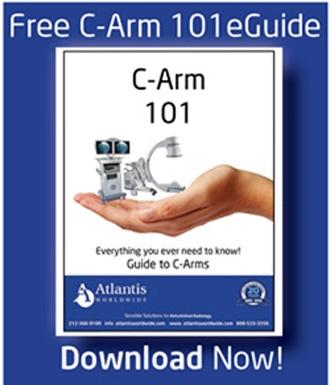Call Today 1-800-533-3356

C-Arm Refurbished
A Step-by-Step Process
- Step 1. System is Cleaned
- Upon arrival at our facility, the system is externally cleaned and disinfected.
- System is fully tested and a report is generated. Problems are either repaired at this time, or if it is more practical to make the repair when the system is dismantled, then needed repairs are noted on the report, which stays with the machine throughout the process.
- Old patient data and images are erased.
- System is dismantled and any additional problems or potential problems found are noted the on report or repaired at this time.
- System is internally disinfected at this time.
- Subassemblies are dismantled, disinfected, and moved to respective service areas.
- Old hospital labels, tape, adhesive, etc, are removed.
- Step 2. System is Painted
- Dismantled units and components are moved to the paint facility.
- Units and components to be painted are sanded, have dents removed orfilled, have scratches sanded out or filled, and then a primer coat is applied.
- Two coats of high quality polyurethane paint are applied.
- After curing for 24 hours, painted units and components are brought back to their designated reassembly areas.
- Step 3. System is Checked & Repaired
- Wheels and casters are checked, cleaned, and replaced as necessary. C-Arm steering system is adjusted and aligned with steering handle.
- C-Arm and monitor cart are reassembled.
- All locks, handles, and brakes are adjusted or replaced as necessary.
- All switches, connectors, breakers, and fuses are checked and replaced as necessary.
- The foot-switch cable and connector are checked and replaced as necessary.
- High voltage cables are cleaned and new grease is applied.
- X-ray tube is checked for excessive bearing noise and tungsten buildup on the outlet port. A poor x-ray tube is replaced with one that meets our specifications.
- Image intensifier is checked for artifacts and replaced with better one if necessary.
- Image intensifier mode sizes are checked and adjusted as necessary.
- Corroded fasteners are replaced in most cases with stainless steel hardware.
- Step 4. System is Calibrated and Tested
- Field service safety bulletins are performed when we determine they have not already been completed in the field.
- X-ray beam alignment and collimator calibration is performed.
- Video camera system and image intensifier are focused and adjusted to highest achievable resolution.
- C-Arm and monitor cart power supplies are adjusted to specifications.
- C-Arm batteries are replaced and battery charger voltage is adjusted to specifications.
- X-ray generator system calibration is performed and report generated.
- Video monitor geometry is set up and settings are adjusted with service software as needed.
- System is thoroughly tested and all functions are checked.
- Vascular operational features are checked if system is ordered with this option.
- The sending of images is tested if system is ordered with DICOM capabilities.
- Dose output is set to meet FDA regulations and a report is generated.
- System is burned in for 24 hours.
- Step 1. System is Cleaned
- Upon arrival at our facility, the system is externally cleaned and disinfected.
- System is fully tested and a report is generated. Problems are either repaired at this time, or if it is more practical to make the repair when the system is dismantled, then needed repairs are noted on the report, which stays with the machine throughout the process.
- Old patient data and images are erased.
- System is dismantled and any additional problems or potential problems found are noted the on report or repaired at this time.
- System is internally disinfected at this time.
- Subassemblies are dismantled, disinfected, and moved to respective service areas.
- Old hospital labels, tape, adhesive, etc, are removed.
- Step 2. System is Painted
- Dismantled units and components are moved to the paint facility.
- Units and components to be painted are sanded, have dents removed orfilled, have scratches sanded out or filled, and then a primer coat is applied.
- Two coats of high quality polyurethane paint are applied.
- After curing for 24 hours, painted units and components are brought back to their designated reassembly areas.
- Step 3. System is Checked & Repaired
- Wheels and casters are checked, cleaned, and replaced as necessary. C-Arm steering system is adjusted and aligned with steering handle.
- C-Arm and monitor cart are reassembled.
- All locks, handles, and brakes are adjusted or replaced as necessary.
- All switches, connectors, breakers, and fuses are checked and replaced as necessary.
- The foot-switch cable and connector are checked and replaced as necessary.
- High voltage cables are cleaned and new grease is applied.
- X-ray tube is checked for excessive bearing noise and tungsten buildup on the outlet port. A poor x-ray tube is replaced with one that meets our specifications.
- Image intensifier is checked for artifacts and replaced with better one if necessary.
- Image intensifier mode sizes are checked and adjusted as necessary.
- Corroded fasteners are replaced in most cases with stainless steel hardware.
- Step 4. System is Calibrated and Tested
- Field service safety bulletins are performed when we determine they have not already been completed in the field.
- X-ray beam alignment and collimator calibration is performed.
- Video camera system and image intensifier are focused and adjusted to highest achievable resolution.
- C-Arm and monitor cart power supplies are adjusted to specifications.
- C-Arm batteries are replaced and battery charger voltage is adjusted to specifications.
- X-ray generator system calibration is performed and report generated.
- Video monitor geometry is set up and settings are adjusted with service software as needed.
- System is thoroughly tested and all functions are checked.
- Vascular operational features are checked if system is ordered with this option.
- The sending of images is tested if system is ordered with DICOM capabilities.
- Dose output is set to meet FDA regulations and a report is generated.
- System is burned in for 24 hours.
System is packed, skidded, or crated per customer request.

